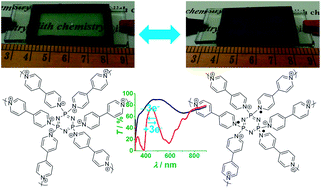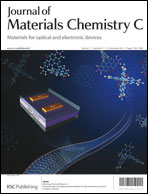A new organo-inorganic hybrid of poly(cyclotriphosphazene-4,4′-bipyridinium)chloride with a large electrochromic contrast†
Abstract
A new organo-inorganic hybrid electrochromic material poly(cyclotriphosphazene-4,4′-bipyridinium)chloride salt was synthesized wherein each phosphorus atom in the triphosphazene core is linked by diquaternized 4,4′-bipyridyls (PPBP). The electrochrome was characterized by 31P nuclear magnetic resonance, Fourier transform infrared spectroscopy and X-ray photoelectron spectroscopy (XPS). XPS confirmed the formation of P–N+ and P–N linkages in the PPBP and the conversion of covalently bound Cl to ionic Cl− species. The transparent PPBP material undergoes three reversible one electron-transfer reactions to yield a radical cation insoluble film which first acquires a purple hue and then turns deep blue. Electrochromic devices were constructed with the PPBP hybrid dissolved in a highly conductive, thermally stable and electrochemically inert ionic liquid based gel electrolyte and a Prussian blue (PB) layer as the anode. The PPBP–PB device showed an extremely large coloration efficiency of 504 cm2 C−1, an exceptionally high transmission modulation of 70.5% at 590 nm, one among the highest reported contrasts in organic electrochromics, a large reflectance contrast of 59.2% at 545 nm and fast switching kinetics. The device was durable as it retained 96.2% of its original transmission after 1000 color-bleach cycles, thus exemplifying its use for both reflective and transmissive electrochromic applications. Electrochemical impedance studies revealed charge transfer to be a less resistive process during reduction relative to oxidation which cumulatively ensues in shorter coloration times. Our studies demonstrate the yet untapped potential of the inorganic (PNCl2)3 in steering the synthesis of new organo-inorganic hybrid materials, capable of undergoing facile redox phenomena, manifesting in unequalled functional properties and thereby offering opportunities to use this trimer for preparing a whole gamut of new high performance electroactive compounds.


 Please wait while we load your content...
Please wait while we load your content...